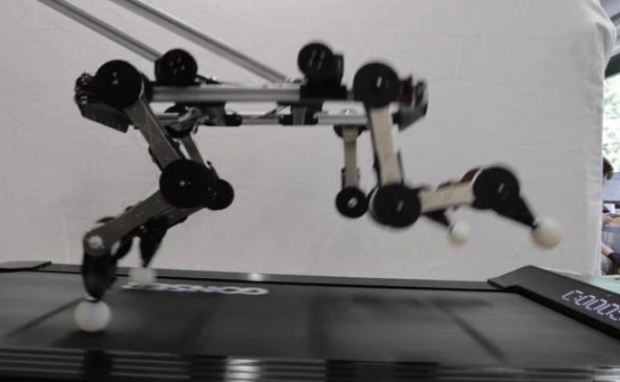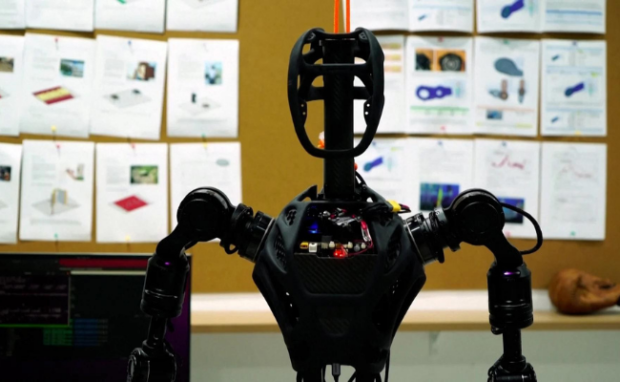Dog robot keeps moving without motors
A robotics student from Switzerland’s École Polytechnique Fédérale de Lausanne (EPFL) research institute developed a new dog robot design. Mickaël Achkar enabled his canine robot frame body to move indefinitely once given enough momentum. However, he claims he does not intend to compete against high-end robotic pooches.
Many marvel at robots moving and performing tasks, but most don’t realize their intricacies. Believe it or not, these machines merge form and function, ensuring their design facilitates their purpose. Small innovations like Achkar’s work may seem trivial, but they could help create more effective robots. As a result, his work may bring us closer to a better robotic future.
This article will discuss how Achkar designed his machine pet and explain its implications for robotics. Later, I will illustrate modern robotics progress by covering similar projects.
How does Achkar’s dog robot work?

Photo Credit: miragenews.com
Swiss-based science news outlet myScience shared details regarding Mickaël Achkar’s research. It said the student studied canine biological mechanisms to “create a smarter robot design and build a prototype that can run by itself once set in motion.”
“I wanted to engineer a robot with animal characteristics, bearing in mind that animals – like humans – move in a huge variety of ways,” he stated. “But most of these movements are executed by just a few joints,” Achkar added.
Consequently, he drew inspiration from animal motor control processes to guide his design. Achkar could have picked any animal but thought a dog was the most obvious choice.
“We found a vast dataset on the motion of dogs, and it was even available in open source!” the robotics student said. He started by extracting data on synergistic dog movements and then structured the data.
Synergistic movements involve multiple muscles. For example, Flint Rehab says four muscles work together to enable walking. Afterward, the researcher structured the data to “summarize” it meaningfully.
You may also like: Police robots keep Singapore Airport safe
This process involved grouping data into several vectors describing the main axes of dog motion. Next, Achkar used this information to establish the exact specifications for his robot.
He created the body with metal rods, 3D-printed pulleys, thin cables, and screws. Then, Achkar and his colleagues tested it on a treadmill. As a result, they discovered it could run autonomously without activating its motors.
The dog robot could walk due to the treadmill’s friction and force, thanks to its counterweight. Francesco Stella, the project supervisor, said, “We designed the robot’s body to be able to respond automatically, much like a trout starts swimming automatically when placed in water.”
What’s the latest in robotics?

Photo Credit: scmp.com
The dog robot from Switzerland isn’t the only recent robotics project. For example, China allegedly unveiled the “world’s first mass-produced humanoid robot.”
It can walk on two legs at 5kph while carrying a 50 kg load. Chinese firm Fourier Intelligence declared the GR-1 prototype bot to solve China’s growing elderly population and shrinking labor market.
Carnegie Mellon University also created a robot that helps older people: the Head-Worn Assistive Teleoperation (HAT) device. Wearing it enables a user to move a robot hand with head motions and voice commands.
You may also like: ChatGPT is developing ChatGPT robots
You direct where the arm is facing by moving your head. Afterward, you can order it to move its arm, wrist, and gripper. As a result, it can help folks with movement difficulties.
The Massachusetts Institute of Technology developed a project similar to Mickaël Achkar’s. It improves existing robot designs but focuses on software instead of hardware.
Electrical engineering and computer science graduate student Andi Peng and her colleagues created a way to train robots faster. Their algorithm detects robot errors so that an engineer can correct them immediately. As a result, engineers can make their bots perform specific tasks faster.
Conclusion
Robotics student Mickaël Achkar created a dog robot that keeps moving once it gains enough momentum. It mimics a real dog’s movements to make this feat possible.
This discovery may seem mundane, but that’s how science usually works. Contrary to popular belief, its practical applications don’t come from bombastic breakthroughs.
Instead, they are a culmination of small successes and failures. One day, his design may lead to more robotics innovations. Learn more about these digital trends at Inquirer Tech.